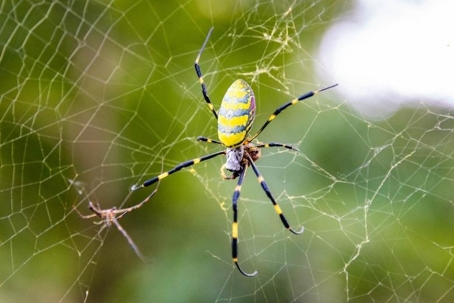Can Joro Spiders Bite?
Yes, Joro spiders can bite.
Do Joro Spiders Bite?
Joro spiders (Trichonephila clavata) are large, colorful orb-weaving spiders originally from East Asia and now found in parts of the United States. Despite their intimidating size, these spiders are generally not aggressive toward humans or pets. Bites are extremely rare and usually occur only under certain circumstances:
Direct Handling or Disturbance: The most common situation leading to a bite is when someone intentionally picks up, grabs, or otherwise disturbs the spider. This includes trying to remove it from a web or moving it from a structure.
Accidental Contact: If a spider becomes trapped against skin—such as in clothing, bedding, or when someone reaches into dense foliage near its web—it may bite defensively.
Cornered or Threatened: If a Joro spider feels trapped with no escape route, it may bite as a last-resort defense. This is uncommon because they usually retreat when disturbed.
Pet Interaction: Pets that bat at, paw at, or try to eat the spider could provoke a defensive bite, though this is extremely rare due to the spider’s reclusive nature.
In general, Joro spiders are more likely to flee than bite. Their venom is considered mild and not dangerous to humans or pets—usually causing only minor redness, swelling, or irritation if a bite occurs.
Are Joro Spiders Venomous?
Yes, Joro spiders (Trichonephila clavata) are technically venomous, because they produce venom to subdue prey. However, their venom is mild and not considered dangerous to humans or pets.
Key points about their venom:
Purpose: The venom is primarily used to immobilize insects, which are their main food source.
Effects on humans: A bite may cause minor symptoms such as localized pain, redness, swelling, or itching—similar to a mild bee sting. Severe reactions are extremely rare.
Effects on pets: Most household pets are unlikely to suffer serious effects; a small localized reaction could occur if a pet is bitten.
Medical attention: Usually unnecessary, unless the bite triggers an unusual allergic reaction (e.g., significant swelling, hives, or difficulty breathing), in which case prompt medical care is advised.
While technically venomous, Joro spiders pose minimal risk to humans and pets.
Joro Spider Bites
Joro spider (Trichonephila clavata) bites are extremely rare, and the risks are generally minimal. When a bite does occur, the main risks are:
Mild Local Reactions: Redness, swelling, or itching at the bite site. Minor pain or a burning sensation, usually lasting a few hours to a day.
Allergic Reactions: Rarely, some individuals may have an allergic reaction, which could cause more pronounced swelling, hives, or itching. Severe allergic reactions (anaphylaxis) are exceedingly uncommon but would require immediate medical attention.
Secondary Infection: As with any puncture wound, there is a small risk of bacterial infection if the bite area is scratched or not kept clean.
Psychological Discomfort: For some people, simply knowing they were bitten by a large spider can cause anxiety or stress, but this is not a physical health risk.
Joro spiders are not medically dangerous. Their venom is mild, and serious complications are almost nonexistent. Standard first aid—washing the bite, applying an antiseptic, and monitoring for unusual reactions—is usually sufficient.
What Do Joro Spider Bites Look Like?
Bites from Joro spiders (Trichonephila clavata) are rare and generally mild. When they do occur, the appearance of the bite is usually subtle and not dramatic. Typical features include:
Small Puncture Marks: Usually one or two tiny punctures from the spider’s fangs. Often difficult to see, especially on darker skin.
Redness and Swelling: Localized redness around the bite site. Mild swelling, sometimes forming a small raised bump.
Itching or Minor Pain: The area may feel itchy, tender, or slightly warm. Pain is generally minimal and short-lived.
Rare Secondary Symptoms: In unusual cases, mild bruising or a small blister may form. Severe reactions are extremely uncommon.
A Joro spider bite looks similar to a minor insect bite—far less noticeable than bites from more medically significant spiders like black widows or brown recluses.
What To Do About Joro Spider Bites
If you are bitten by a Joro spider (Trichonephila clavata), the steps to take are straightforward because their bites are generally mild:
Clean the Bite: Wash the area gently with soap and water to remove any bacteria and reduce the risk of infection.
Apply a Cold Compress: Use a cold pack or a clean cloth with ice for 10–15 minutes to reduce swelling and discomfort.
Relieve Symptoms: Over-the-counter pain relievers like acetaminophen or ibuprofen can help with pain. Anti-itch creams or antihistamines can reduce itching or minor allergic reactions.
Monitor for Complications: Most bites heal within a day or two with only minor redness or swelling. Watch for unusual signs such as spreading redness, pus, increasing pain, or systemic symptoms (fever, dizziness, severe swelling), which could indicate infection or an allergic reaction.
Seek Medical Attention if Needed: Although serious reactions are rare, seek prompt medical care if you experience difficulty breathing or swallowing, severe or spreading swelling, intense pain that worsens over time, or signs of infection.
Avoid Further Bites: Do not handle the spider again. Wear gloves when cleaning areas where Joro spiders may reside, like outdoor structures, corners, or dense foliage.
Essentially, a Joro spider bite is treated like a minor insect bite unless unusual symptoms develop.

